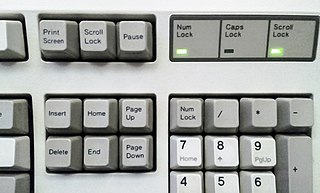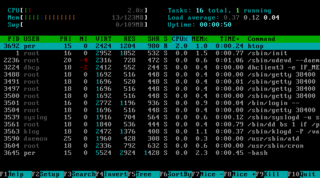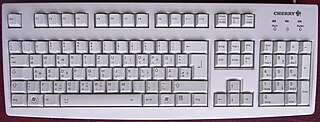Related Research Articles

Scroll Lock is a lock key on most IBM-compatible computer keyboards.

ANSI escape sequences are a standard for in-band signaling to control cursor location, color, font styling, and other options on video text terminals and terminal emulators. Certain sequences of bytes, most starting with an ASCII escape character and a bracket character, are embedded into text. The terminal interprets these sequences as commands, rather than text to display verbatim.

COMMAND.COM is the default command-line interpreter for MS-DOS, Windows 95, Windows 98 and Windows Me. In the case of DOS, it is the default user interface as well. It has an additional role as the usual first program run after boot, hence being responsible for setting up the system by running the AUTOEXEC.BAT configuration file, and being the ancestor of all processes.

A computer terminal is an electronic or electromechanical hardware device that can be used for entering data into, and transcribing data from, a computer or a computing system. The teletype was an example of an early-day hard-copy terminal and predated the use of a computer screen by decades.
An environment variable is a user-definable value that can affect the way running processes will behave on a computer. Environment variables are part of the environment in which a process runs. For example, a running process can query the value of the TEMP environment variable to discover a suitable location to store temporary files, or the HOME or USERPROFILE variable to find the directory structure owned by the user running the process.

In DOS memory management, conventional memory, also called base memory, is the first 640 kilobytes of the memory on IBM PC or compatible systems. It is the read-write memory directly addressable by the processor for use by the operating system and application programs. As memory prices rapidly declined, this design decision became a limitation in the use of large memory capacities until the introduction of operating systems and processors that made it irrelevant.

In computing, text-based user interfaces (TUI), is a retronym describing a type of user interface (UI) common as an early form of human–computer interaction, before the advent of bitmapped displays and modern conventional graphical user interfaces (GUIs). Like modern GUIs, they can use the entire screen area and may accept mouse and other inputs. They may also use color and often structure the display using box-drawing characters such as ┌ and ╣. The modern context of use is usually a terminal emulator.
CONFIG.SYS is the primary configuration file for the DOS and OS/2 operating systems. It is a special ASCII text file that contains user-accessible setup or configuration directives evaluated by the operating system's DOS BIOS during boot. CONFIG.SYS was introduced with DOS 2.0.
AUTOEXEC.BAT is a system file that was originally on DOS-type operating systems. It is a plain-text batch file in the root directory of the boot device. The name of the file is an abbreviation of "automatic execution", which describes its function in automatically executing commands on system startup; the filename was coined in response to the 8.3 filename limitations of the FAT file system family.

Windows Console is the infrastructure for console applications in Microsoft Windows. An instance of a Windows Console has a screen buffer and an input buffer. It allows console apps to run inside a window or in hardware text mode. The user can switch between the two using the Alt+↵ Enter key combination. The text mode is unavailable in Windows Vista and later. Starting with Windows 10, however, a native full-screen mode is available.

DOS/V is a Japanese computing initiative starting in 1990 to allow DOS on IBM PC compatibles with VGA cards to handle double-byte (DBCS) Japanese text via software alone. It was initially developed from PC DOS by IBM for its PS/55 machines, but IBM gave the driver source code to Microsoft, who then licensed a DOS/V-compatible version of MS-DOS to other companies. Kanji fonts and other locale information are stored on the hard disk rather than on special chips as in the preceding AX architecture. As with AX, its great value for the Japanese computing industry is in allowing compatibility with foreign software. This had not been possible under NEC's proprietary PC-98 system, which was the market leader before DOS/V emerged. DOS/V stands for "Disk Operating System/VGA". In Japan, IBM compatible PCs became popular along with DOS/V, so they are often referred to as "DOS/V machine" or "DOS/V pasocom" even though DOS/V operating systems are no longer common.
EMM386 is the expanded memory manager of Microsoft's MS-DOS, IBM's PC DOS, Digital Research's DR-DOS, and Datalight's ROM-DOS which is used to create expanded memory using extended memory on Intel 80386 CPUs. There also is an EMM386.EXE available in FreeDOS.

On computer keyboards, the Esc keyEsc is a key used to generate the escape character. The escape character, when sent from the keyboard to a computer, often is interpreted by software as "stop", and when sent from the computer to an external device marks the beginning of an escape sequence to specify operating modes or characteristics generally.

In computing, tree is a recursive directory listing command or program that produces a depth-indented listing of files. Originating in PC- and MS-DOS, it is found in Digital Research FlexOS, IBM/Toshiba 4690 OS, PTS-DOS, FreeDOS, IBM OS/2, Microsoft Windows, and ReactOS. A version for Unix and Unix-like systems is also available.
.sys is a filename extension used in MS-DOS applications and Microsoft Windows operating systems. They are system files that contain device drivers or hardware configurations for the system.

DOS is a family of disk-based operating systems for IBM PC compatible computers. The DOS family primarily consists of Microsoft's MS-DOS and a rebranded version, IBM PC DOS, both of which were introduced in 1981. Later compatible systems from other manufacturers include DR-DOS (1988), ROM-DOS (1989), PTS-DOS (1993), and FreeDOS (1998). MS-DOS dominated the IBM PC compatible market between 1981 and 1995.

The Linux console is a system console internal to the Linux kernel. A system console is the device which receives all kernel messages and warnings and which allows logins in single user mode. The Linux console provides a way for the kernel and other processes to send text output to the user, and to receive text input from the user. The user typically enters text with a computer keyboard and reads the output text on a computer monitor. The Linux kernel supports virtual consoles – consoles that are logically separate, but which access the same physical keyboard and display. The Linux console are implemented by the VT subsystem of the Linux kernel, and do not rely on any user space software. This is in contrast to a terminal emulator, which is a user space process that emulates a terminal, and is typically used in a graphical display environment.
Control-Alt-Delete is a computer keyboard command on IBM PC compatible computers, invoked by pressing the Delete key while holding the Control and Alt keys: Ctrl+Alt+Delete. The function of the key combination differs depending on the context but it generally interrupts or facilitates interrupting a function. For instance, in pre-boot environment or in MS-DOS, Windows 3.0 and earlier versions of Windows or OS/2, the key combination reboots the computer. Starting with Windows 95, the key combination invokes a task manager or security related component that facilitates ending a Windows session or killing a frozen application.
References
- ↑ Mefford, Michael (1989-02-07). "ANSI.com: Download It Here". PC Magazine . Retrieved 2011-08-10.
- 1 2 Kegel, Daniel; Almy, Tom; Auer, Eric (1999-02-28). "NANSI – An Enhanced MS-DOS Console Driver". 4.0. Dan Kegel's Web Hostel. Archived from the original on 2018-05-19. Retrieved 2011-08-10.
- 1 2 Sweger, Kristofer (2007) [2000]. "Configuring ANSIPLUS". Archived from the original on 2018-10-04. Retrieved 2018-10-04.
- 1 2 3 "Guide to using ANSI.SYS". Archived from the original on 2007-06-23. Retrieved 2017-09-11.
- ↑ Paul, Matthias R. (1997-07-30) [1994-05-01]. NWDOS-TIPs — Tips & Tricks rund um Novell DOS 7, mit Blick auf undokumentierte Details, Bugs und Workarounds. Archived from the original on 2017-09-10. Retrieved 2014-08-06.
{{cite book}}:|work=ignored (help) (NB. NWDOSTIP.TXT is a comprehensive work on Novell DOS 7 and OpenDOS 7.01, including the description of many undocumented features and internals. It is part of the author's yet larger MPDOSTIP.ZIP collection maintained up to 2001 and distributed on many sites at the time. The provided link points to a HTML-converted older version of the NWDOSTIP.TXT file.) - ↑ "ANSI Keyboard codes - ANSI.SYS Key and Extended Key Codes". µVGA - VGA Microcontroller interface. SECONS Ltd. 2012. Archived from the original on 2017-09-11. Retrieved 2017-09-11.
- ↑ Datalight, Inc.; GPvNO (April 2005) [1999]. "Datalight ROM-DOS User's Guide" (PDF). Datalight, Inc. 3010-0200-0716. Retrieved 2018-09-16.
- ↑ "PTS-DOS 2000 Pro User Manual" (PDF). Buggingen, Germany: Paragon Technology GmbH. 1999. Archived (PDF) from the original on 2018-05-12. Retrieved 2018-05-12.
- ↑ Günther, Jens; Ernst, Tobias (2004-04-25) [1996]. Ellsässer, Wolfgang (ed.). "Inoffizielle deutschsprachige PTS-DOS-FAQ (PTS/FAQD)" [Inofficial German PTS-DOS FAQ] (in German). Retrieved 2018-10-02.
- ↑ Massingill, Michael D. Pearson, Dave (ed.). "PK SAFE ANSI (PKSFANSI.COM)". Archived from the original on 2017-09-11. Retrieved 2017-09-11.
- ↑ Field, Tim (November 1983). "Installable Device Drivers for PC DOS 2.0 - Inside the IBM PC". BYTE . 8 (11): 188–196. Retrieved 2016-03-19.
- 1 2 3 4 "Chapter 9: Configuring the System". Caldera, Inc. 1998. Archived from the original on 2017-09-10. Retrieved 2017-09-10. (NB. DR-DOS 7 user documentation, description of ANSI.SYS escape sequences (incomplete))
- ↑ "Console Virtual Terminal Sequences". Windows Console. 20 September 2022.